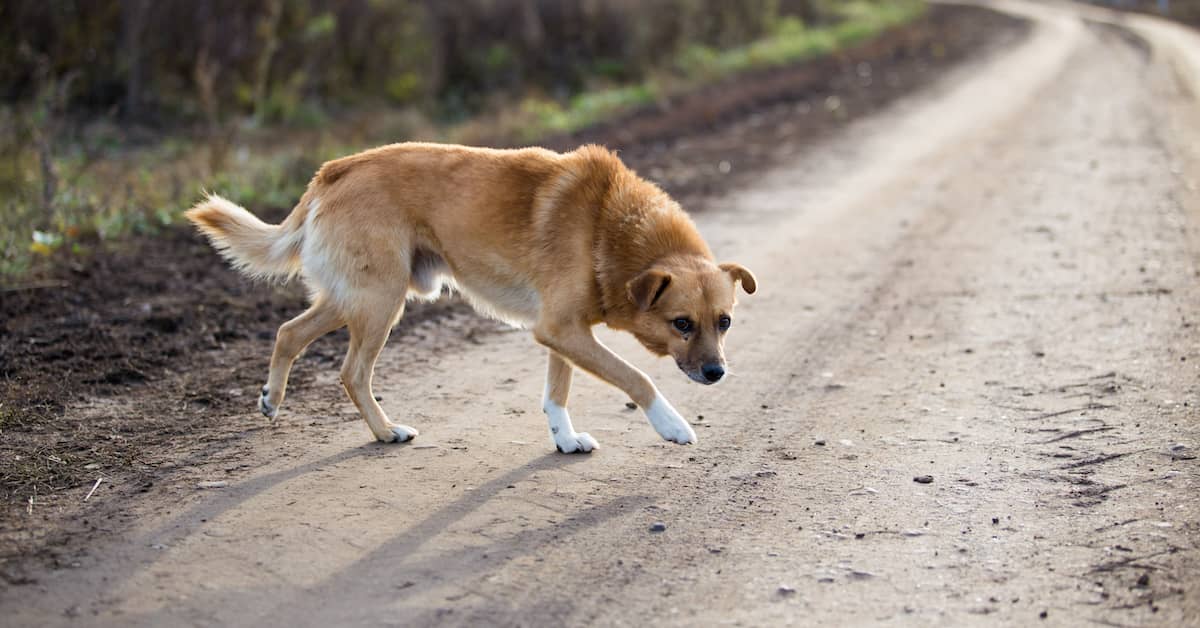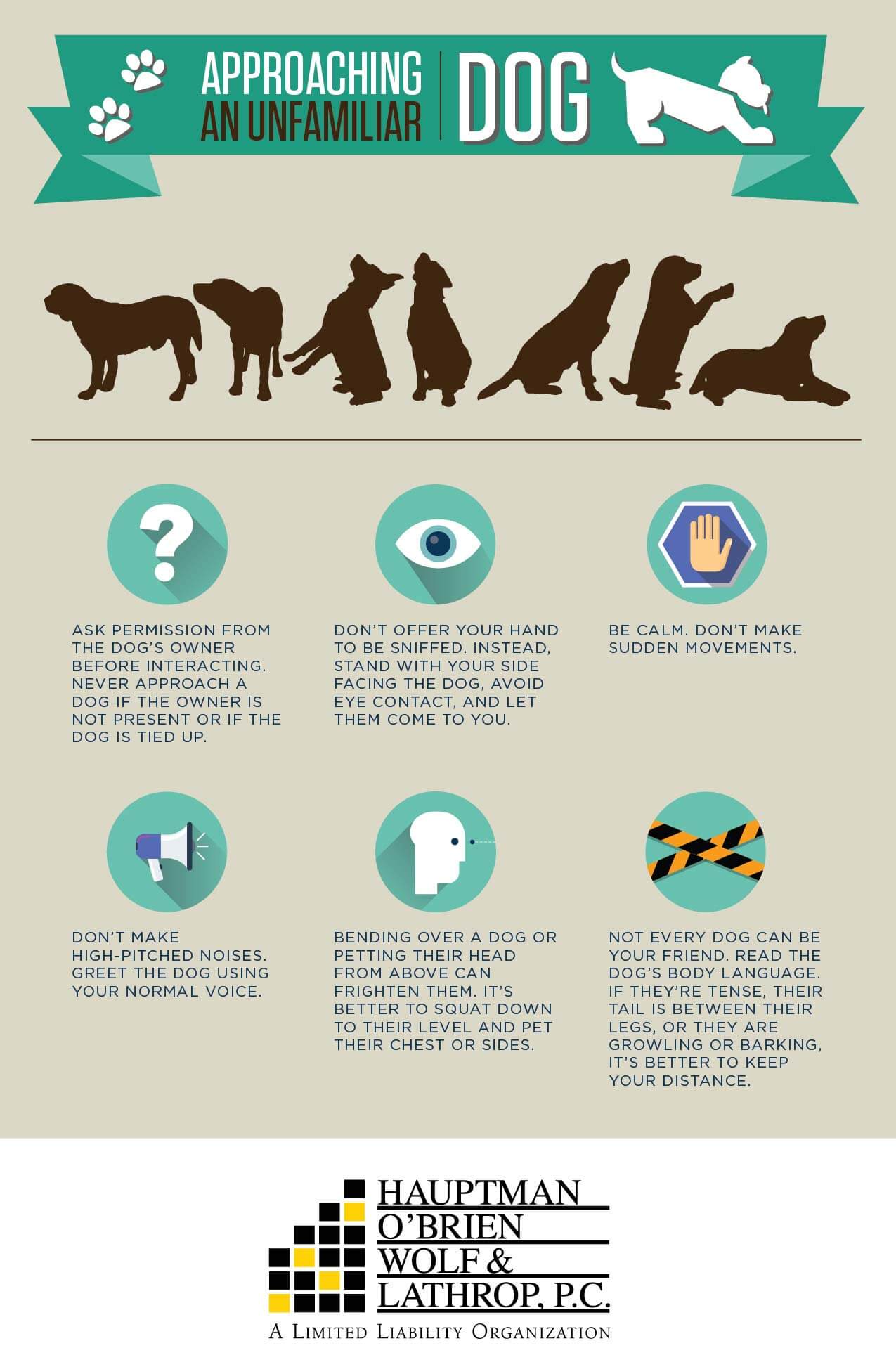
Dogs have been our companions for centuries. That kind of familiarity often leads some wanting to approach and pet an unfamiliar dog. That said, there are six things you should do when approaching a dog you don’t know (or who doesn’t know you).
- Ask permission from the dog’s owner before interacting. Never approach a dog if the owner is not present or if the dog is tied up.
- Don’t offer your hand to be sniffed. Instead, stand with your side facing the dog, avoid eye contact, and let them come to you.
- Be Calm. Don’t make sudden movements.
- Don’t make high-pitched noises. Greet the dog using your normal voice.
- Bending over a dog or petting their head from above can frighten them. It’s better to squat down to their level and pet their chest or sides.
- Not every dog can be your friend. Read the dog’s body language. Keep your distance if they’re tense, their tail is between their legs, or they are growling.
Dog Bite FAQs
Should You Approach a Dog Palm Up or Palm Down?
If you must approach an unfamiliar or unknown dog, the best way to do so is with your hands flat and your palm facing upward. And when you get close, don’t put your hand above the dog’s face or head. This action can be triggering for some dogs and can make them bite or attack the person.
Instead, reach to the side of the dog’s face, under the chin or the shoulder. These gestures communicate to the dog that you’re being friendly. This is in contrast to the palm down approach that many people practice.
Many of the 4.5 million dog bite victims in the United States typically try to pat a dog’s face or head. So, avoid patting gestures and be extra careful when approaching an unfamiliar dog.
What Are the Signs That a Dog Might Be Dangerous?
To tell if a dog is dangerous, look for the following signs:
- Growling: Dogs tend to growl when they’re angry or scared. It’s their way of warning the person who is causing them to feel that way.
- Clenching, baring, or showing teeth: This happens when the dog feels stressed, threatened, confused, or intimidated; it’s typically a sign that they are about to attack.
- Snarling: This is a combination of showing teeth and growling. Dogs typically snarl when there’s an impending attack.
- Lunging: This is either an attempt to scare or attack you. It’s usually preceded by a snarl, growling, barking, or teeth-clenching.
- Becoming still while growling: This is also referred to as “freezing.” If you see this, it means an attack is imminent and you need to stay away from the dog or immediately stop whatever you’re doing to the dog.
- Sprinting aggressively towards you or the target: When a dog dashes aggressively at you or someone else, it’s likely going to attack.
- Eye contact: If a dog approaches you, becomes still, and stares directly at you, it is likely about to attack.
It is important to identify these aggressive behaviors in dogs and take preventive measures to avoid attacks or bites.
Is It Safe to Approach a Dog in My Neighbor's Yard?
No, it’s not—not without the dog owner’s permission. People who try to pet an unfamiliar dog through the fence or on the neighbor’s property leave themselves open to a dog attack. This is because the dog will think they’re trespassing or trying to break into the property.
Some dogs are trained to protect their owner’s property and defend their “territory.” As such, they may become aggressive if you attempt to approach them on their turf. This applies whether you’re a familiar person or not.
Which Dog Breeds Are More Prone to Bites and Attacks?
All dogs can bite. However, some dog breeds are naturally aggressive and are more likely to attack you. These include:
- Pit Bulls
- Cane Corso
- Bulldogs
- Presa Canario
- Terriers
- German Shepherds
- Doberman Pinschers
- Rottweilers
- Akitas
- Alaskan Malamute
According to a report by the American Animal Hospital Association, pit bulls, terriers, German shepherds, and rottweilers appear to pose the highest biting risk. If the dog you intend to touch or pet is in one or more of these categories, it is best to avoid them unless you have their owner’s permission.
What Should I Do If I Am Bitten by a Dog?
There are five things you should do if a dog has bitten you:
- First, make sure to stop the bleeding. Then, clean the wound with disinfectants, apply an antibacterial ointment, and cover it with gauze or bandage.
- If the dog is not yours, ask for a vaccination report; specifically one for rabies.
- Get to the hospital and have the injury checked out at a local hospital.
- The doctor will administer post-exposure rabies prophylaxis —alongside other treatments like a tetanus shot—if the dog hasn’t been vaccinated against rabies.
- Depending on the severity of your injury and the accompanying losses, you may need to contact a personal injury lawyer to recover compensation.
Read More: What to Do in Case of a Dog Bite?
What Happens If a Dog Bites a Child?
If your child has suffered a dog bite, get them to the hospital immediately. It doesn’t matter if it was your dog or someone else’s. You need to get the child treated for the attack, no matter how minor the injury may seem.
Even though some dog bites are mild at the time of the incident, the injury can easily degenerate into a more severe health problem if left untreated. Better to have the doctor tell you that it’s a minor injury instead of wrongly assuming that it is not a big deal and the child ends up suffering serious health problems in the future.
So, do not take any chances. Get your child the medical help they need promptly. Then, you may file an injury claim against the dog owner and/or other liable parties if the dog is not yours.
Is the Owner Liable If a Dog Bites?
Nebraska is a strict liability state. Per Nebraska Revised Statutes § 54-601, a dog owner is liable for the damages and injuries caused by their dog’s attack. However, there are two exceptions to this rule:
- The injured victim trespassed or was unlawfully present on the dog owner’s property.
OR - The victim was injured by a law enforcement dog while carrying out official duty.
As long as the injured victim was not trespassing when the dog attacked them, all they have to do to establish liability is show that they weren’t in the wrong when the defendant’s dog attacked them.
You may require the services of an experienced dog bite lawyer when you want to file your claim.



